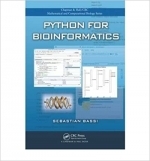Python for Bioinformatics,2009 by Sebastian Bassi

Категория: Other
Поделиться:
Programming knowledge is often necessary for finding a solution to a biological problem. Based on the author’s experience working for an agricultural biotechnology company, Python for Bioinformatics helps scientists solve their biological problems by helping them understand the basics of programming. Requiring no prior knowledge of programming-related concepts, the book focuses on the easy-to-use, yet powerful, Python computer language.
The book begins with a very basic introduction that teaches the principles of programming. It then introduces the Biopython package, which can be useful in solving life science problems. The next section covers sophisticated tools for bioinformatics, including relational database management systems and XML. The last part illustrates applications with source code, such as sequence manipulation, filtering vector contamination, calculating DNA melting temperature, parsing a genbank file, inferring splicing sites, and more. The appendices provide a wealth of supplementary information, including instructions for installing Python and Biopython and a Python language and style guide.
By incorporating examples in biology as well as code fragments throughout, the author places a special emphasis on practice, encouraging readers to experiment with the code. He shows how to use Python and the Biopython package for building web applications, genomic annotation, data manipulation, and countless other applications.
Скачать
Комментарии